Mechanical Properties and Strength Characteristics of Rock–Coal–Rock Assemblages under Different Peripheral Pressures
Abstract
:1. Introduction
2. Triaxial Compression Test of Rock–Coal–Rock Combination
2.1. Preparation of Rock–Coal–Rock Composite Specimen
2.2. Test System and Test Scheme
2.2.1. Testing System
2.2.2. Test Scheme
3. Experiment Results and Analysis
3.1. Analysis of Mechanical Properties of Coal–Rock–Coal Combination
3.2. Analysis of Coal–Rock Failure Characteristics and Residual Strength
3.2.1. Failure Characteristics of Composite Body
3.2.2. Residual Strength Analysis
4. Analysis of Strength Characteristics of Rock–Coal–Rock Combination
4.1. H–B Strength Criterion
4.2. GH–B Strength Criterion
5. Conclusions
- (1)
- The uniaxial compression test on rock–coal–rock specimens showed that, under uniaxial loading conditions, the middle coal body was seriously broken and the degree of discreteness was large, which led to the overall failure and instability of the combination; this is the main reason for the serious deformation of small coal pillars. With the further expansion of cracks, it is possible to cause roof and floor damage;
- (2)
- Under the condition of triaxial loading, the failure strength of the composite increased with an increase in confining pressure. The combined coal samples were dominated by shear failure, and some of the rock samples produced shear surfaces consistent with the coal samples. With an increase in confining pressure, the combination showed obvious characteristics of ductility;
- (3)
- By comparing the relationship between different confining pressure conditions and elastic modulus, peak strengths, peak strains, and residual strengths, it can be seen that the confining pressure of 10–15 MPa is a critical area for the strength change in the combination. After exceeding 15 MPa, the deformation trend of the combination became relatively slow. With an increase in confining pressure, the attenuation coefficient of rock strength gradually decreased, and in the range of 0~10 MPa, the attenuation coefficient of rock strength decreased rapidly, showing that the combination is more sensitive to confining pressure;
- (4)
- Based on the Hoek–Brown strength criterion, the empirical parameter values mi and s suitable for rock–coal–rock combination were solved using a numerical fitting iteration, which can more accurately predict the change in strength characteristics of the combination, and provide a theoretical basis for the width, stability control, and support design of small coal pillars.
Author Contributions
Funding
Institutional Review Board Statement
Informed Consent Statement
Data Availability Statement
Acknowledgments
Conflicts of Interest
References
- Xie, H.P. Research Framework and Anticipated Results of Deep Rock Mechanics and Mining Theory. Adv. Eng. Sci. 2017, 49, 1–16. [Google Scholar] [CrossRef]
- Xie, H.P. Research review of the state key research development program of China: Deep rock mechanics and mining theory. J. China Coal Soc. 2019, 44, 1283–1305. [Google Scholar] [CrossRef]
- Zuo, J.P.; Chen, Y.; Zhang, J.W.; Wang, J.T.; Sun, Y.J.; Jiang, G.H. Failure behavior and strength characteristics of coal-rock combined body under different confining pressures. J. China Coal Soc. 2016, 41, 2706–2713. [Google Scholar] [CrossRef]
- Zuo, J.P.; Chen, Y.; Song, H.Q. Study progress of failure behaviors and nonlinear model of deep coal-rock combined body. J. Cent. South Univ. (Sci. Technol.) 2021, 52, 2510–2521. [Google Scholar]
- Liu, X.H.; Yu, J.; Kang, J.H.; Hao, Q.J. Study on Strength and Deformation Characteristics of Coal-rock under Different Confining Pressures. Chin. J. Undergr. Space Eng. 2019, 15, 1341–1352. [Google Scholar]
- Zheng, J.W.; Wang, S.W.; Li, H.T.; Yang, G.Q.; Lyu, D.Z.; Liu, B.; Fu, Y.K.; Li, X.P.; Lei, G.R. Experimental study on compressive strength characteristics of coal-rock combinations influenced by number of bedding surfaces. Coal Geol. Exploration. 2023, 51, 11–22. [Google Scholar] [CrossRef]
- Yu, W.J.; Pan, B.; Li, K.; Shen, W.B. Mechanical properties and fracture evolution law of rock-coal-rock combination. J. China Coal Soc. 2022, 47, 1155–1167. [Google Scholar] [CrossRef]
- Zhu, W.J.; Zhong, X.Y.; Cheng, Y.Y.; Fei, D.; Zeng, L.R.; Kai, Z. Spatial Distribution of Corrosion Products Influenced by the Initial Defects and Corrosion-Induced Cracking of the Concrete. J. Test. Eval. 2023, 51, 2582–2597. [Google Scholar] [CrossRef]
- Zhu, W.J.; Yang, C.Y.; Yu, Z.X.; Xiao, J.H.; Xu, Y.D. Impact of Defects in Steel-Concrete Interface on the Corrosion-Induced Cracking Propagation of the Reinforced Concrete. KSCE J. Civ. Eng. 2023, 27, 2621–2628. [Google Scholar] [CrossRef]
- Chen, G.B.; Li, T.; Yang, L.; Zhang, G.H.; Li, J.W.; Dong, H.J. Mechanical properties and failure mechanism of combined bodies with different coal-rock ratios and combinations. J. Min. Strat. Control. Eng. 2021, 3, 84–94. [Google Scholar] [CrossRef]
- Zuo, J.P.; Song, H.Q.; Chen, Y.; Li, Y.H. Post-peak progressive failure characteristics and nonlinear model of coal-rock combined body. J. China Coal Soc. 2018, 43, 3265–3272. [Google Scholar] [CrossRef]
- Song, H.Q.; Zuo, J.P.; Chen, Y.; Li, L.Y. Post-peak stress-strain relationship model and brittle characteristics of coal-rock combined body. J. Min. Saf. Eng. 2018, 35, 1063–1070. [Google Scholar] [CrossRef]
- Guo, D.M.; Zuo, J.P.; Zhang, Y.; Yang, R.S. Research on strength and failure mechanism of deep coal-rock combination bodies of different inclined angles. Rock Soil Mech. 2011, 32, 1333–1339. [Google Scholar] [CrossRef]
- Dou, L.M.; Tian, J.C.; Lu, C.P.; Wu, X.R.; Mou, Z.L.; Zhang, X.T.; Li, Z.H. Research on electromagnetic radiation rules of composed coal-rock burst failure. Chin. J. Rock Mech. Eng. 2005, 24, 143–146. [Google Scholar]
- Liu, B.; Yang, R.S.; Guo, D.M.; Zhang, D.Z. Burst-prone experiments of coal-rock combination at −1100 m level in suncun coal mine. Chin. J. Rock Mech. Eng. 2004, 23, 2402–2408. [Google Scholar]
- Li, F.X.; Yin, D.W.; Wang, F.; Jiang, N.; Li, X.L. Effects of combination mode on mechanical properties of bi-material samples consisting of rock and coal. J. Mater. Res. Technol. 2022, 19, 2156–2170. [Google Scholar] [CrossRef]
- Liu, J.; Wang, E.Y.; Song, D.Z.; Wang, S.H.; Niu, Y. Effect of rock strength on failure mode and mechanical behavior of composite samples. Arab. J. Geosci. 2015, 8, 4527–4539. [Google Scholar] [CrossRef]
- Yang, Y.J.; Song, Y.; Chen, S.J. Test study of coal’s strength and deformation characteristics under triaxial compression. J. China Coal Soc. 2006, 31, 150–153. [Google Scholar]
- Liu, Q.S.; Liu, K.D.; Zhu, J.B.; Lu, X.L. Study of mechanical properties of raw coal under high stress with triaxial compression. Chin. J. Rock Mech. Eng. 2014, 33, 24–34. [Google Scholar] [CrossRef]
- Zuo, J.P.; Wang, Z.F.; Zhou, H.W.; Pei, J.L.; Liu, J.F. Failure behavior of a rock-coal-rock combined body with a weak coal interlayer. Int. J. Min. Sci. Technol. 2013, 23, 907–912. [Google Scholar] [CrossRef]
- Guo, W.Y.; Tan, Y.L.; Yu, F.H.; Zhao, T.B.; Hu, S.C.; Huang, D.M.; Qin, Z. Mechanical behavior of rock-coal-rock specimens with different coal thicknesses. Geomech. Eng. 2018, 15, 1017–1027. [Google Scholar] [CrossRef]
- Rafiai, H. New Empirical Polyaxial Criterion for Rock Strength. Int. J. Rock Mech. Min. Sci. 2011, 48, 922–931. [Google Scholar] [CrossRef]
- Labuz, J.F.; Zang, A. Mohr-Coulomb Failure Criterion. Rock Mech. Rock Eng. 2012, 45, 975–979. [Google Scholar] [CrossRef]
- Hoek, E.; Brown, E.T. Empirical strength criterion for rock masses. J. Geotech. Geoenviron. Eng. 1980, 106, 1013–1035. [Google Scholar] [CrossRef]
- Hoek, E.; Wood, D.; Shah, S. A modified Hoek-Brown failure criterion for jointed rock masses. In Proceedings of the Rock Characterization: ISRM Symposium, Eurock ‘92, Chester, UK, 14–17 September 1992; pp. 209–214. [Google Scholar]
- Paterson, M.S.; Wong, T.F. Experimental rock deformation-the brittle field. In Principles and Practice of Constraint Programming—CP 2003, Proceedings of the 9th International Conference, CP 2003, Kinsale, Ireland, 29 September–3 October 2003; Springer: Berlin/Heidelberg, Germany, 2005; p. 348. [Google Scholar] [CrossRef]
- Liu, W.B.; Tang, C.A.; Tang, L.X. Numerical Simulation on influence of Residual Strength on Macroscopic Behavior of Rock Failure. Geotech. Eng. Tech. 2004, 18, 59–63. [Google Scholar]
- You, M.Q.; Hua, A.Z. Strength criterion and internal friction coefficient of rock samples. J. Geomech. 2001, 7, 53–60. [Google Scholar]
- Peng, J.; Rong, G.; Cai, M.; Peng, K. Determination of residual strength of rocks by a brittle index. Rock Soil Mech. 2015, 36, 403–408. [Google Scholar] [CrossRef]
- Hoek, E.; Brown, E.T. Practical Estimates of Rock Mass Strength. Int. J. Rock Mech. Min. Sci. 1997, 34, 1165–1186. [Google Scholar] [CrossRef]



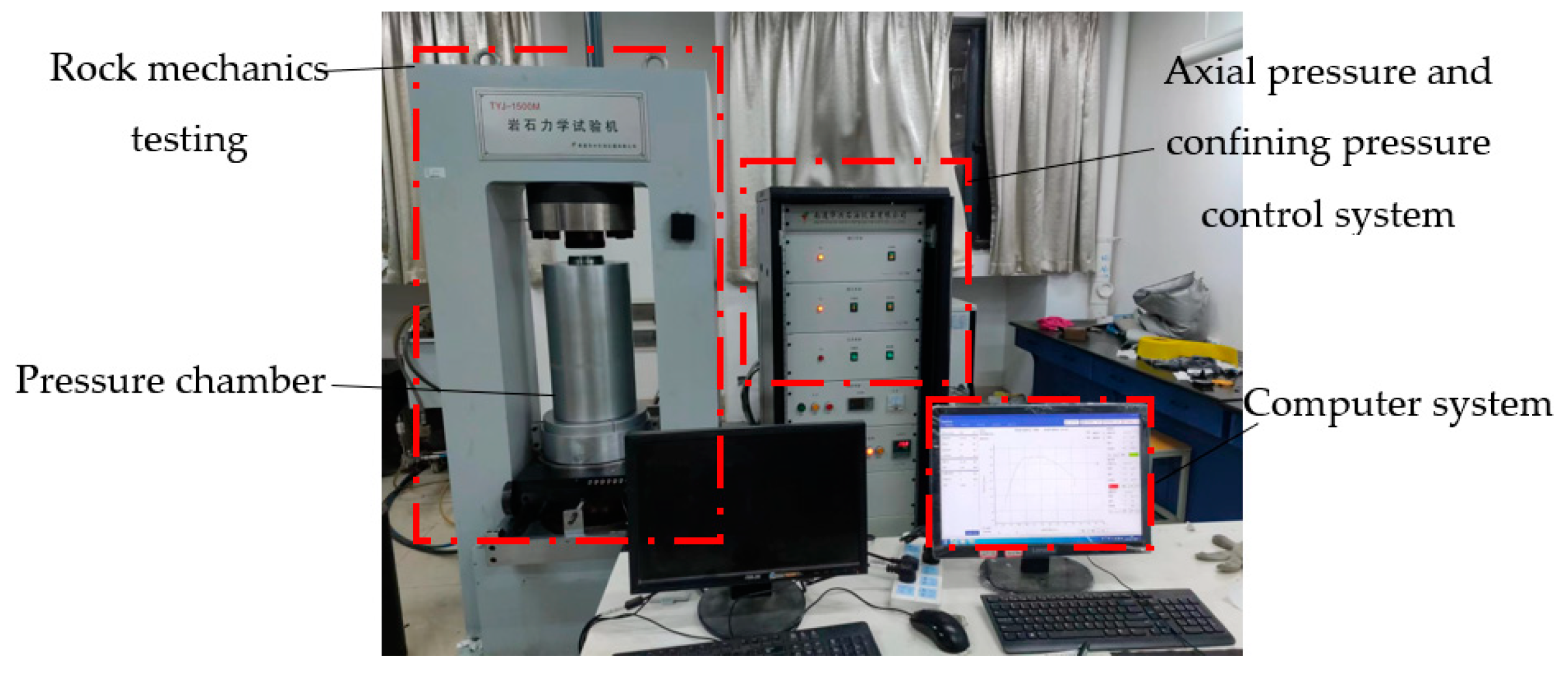
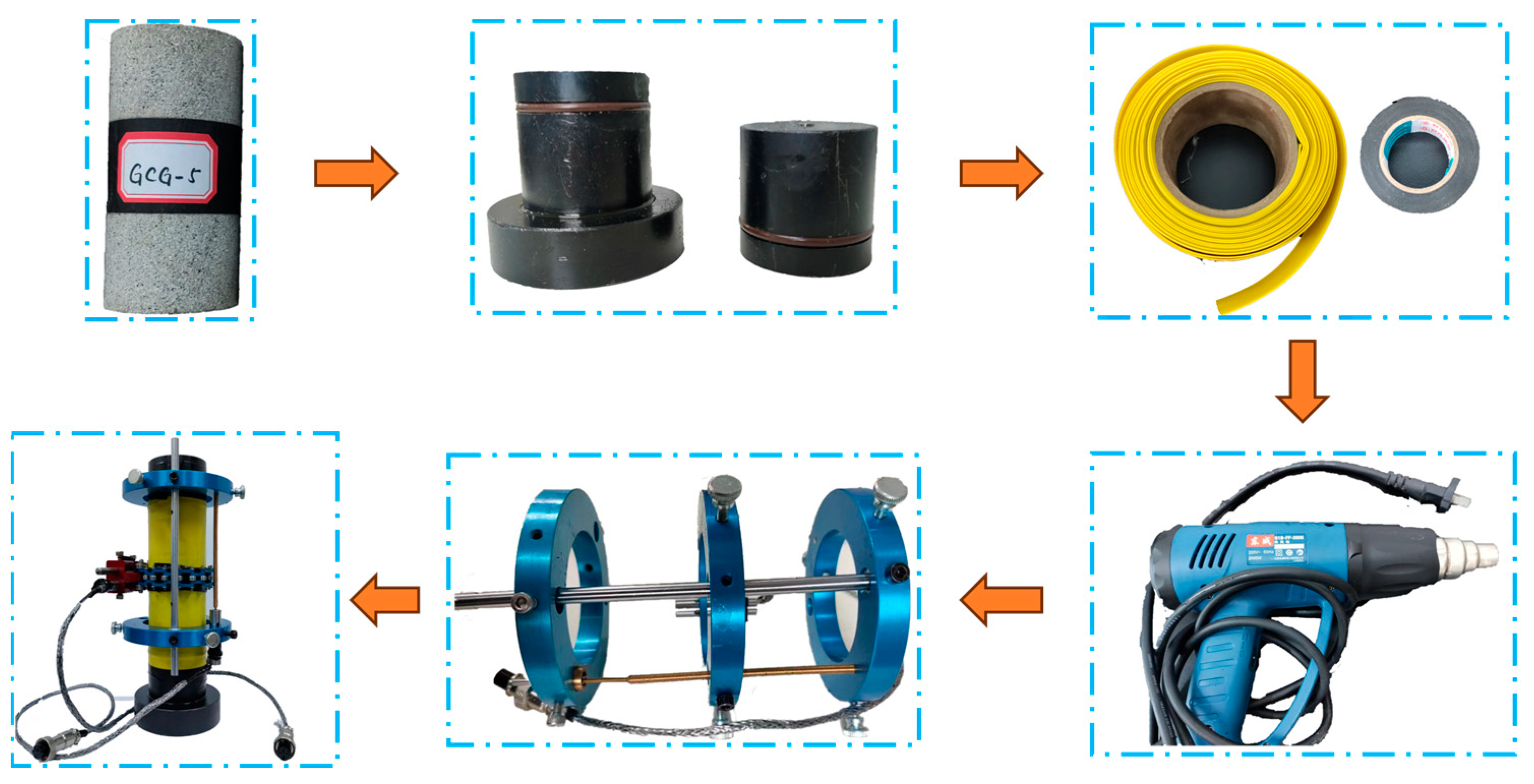

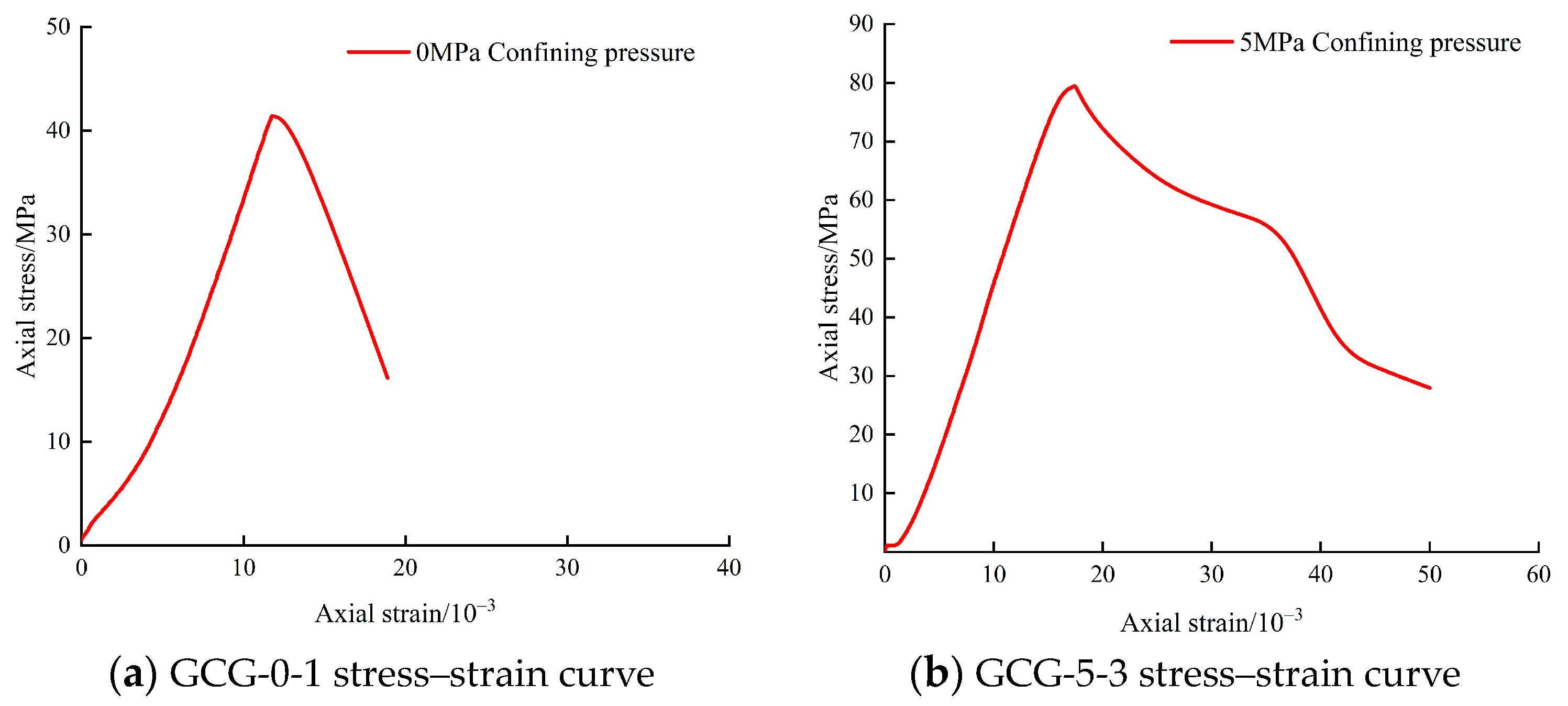


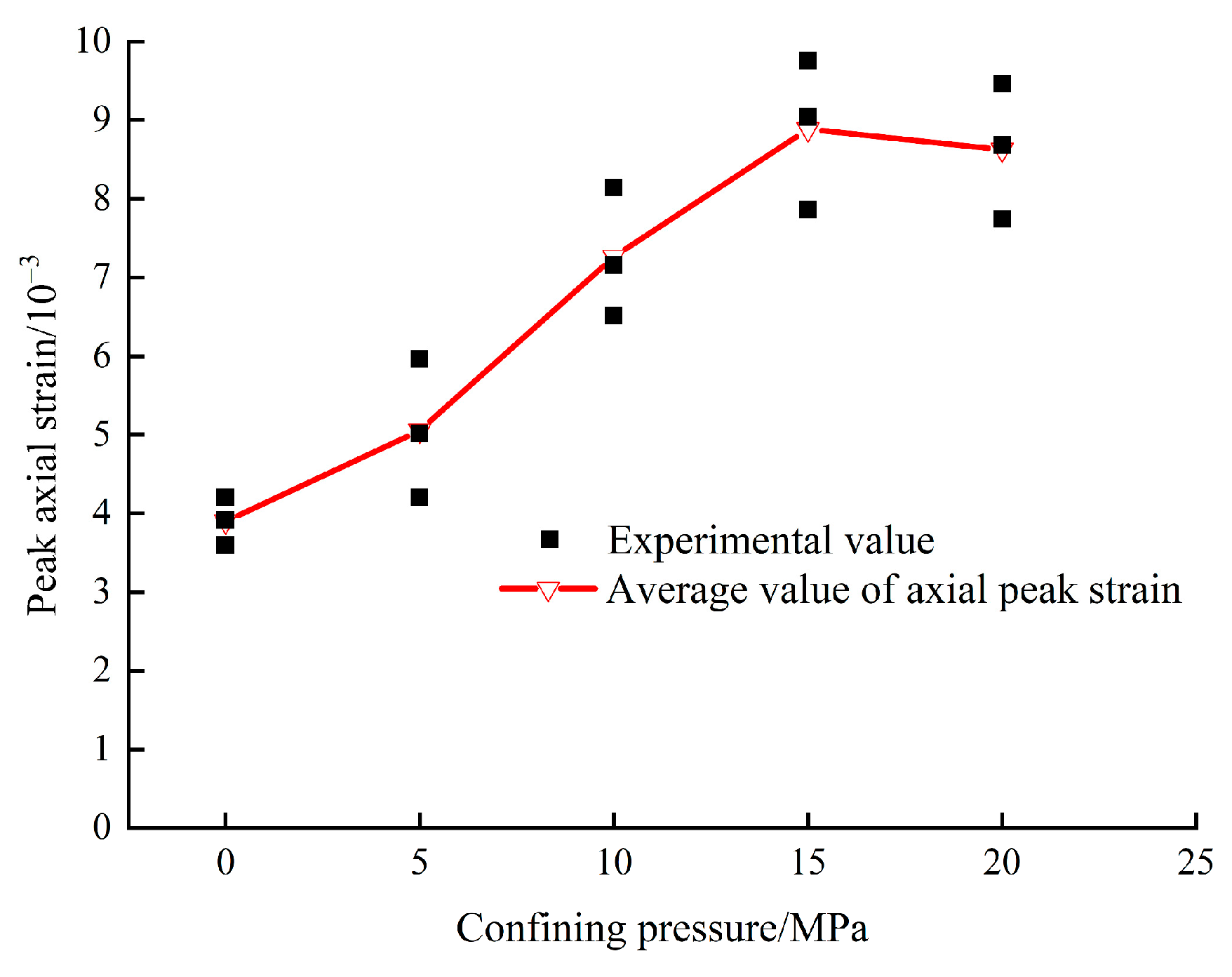
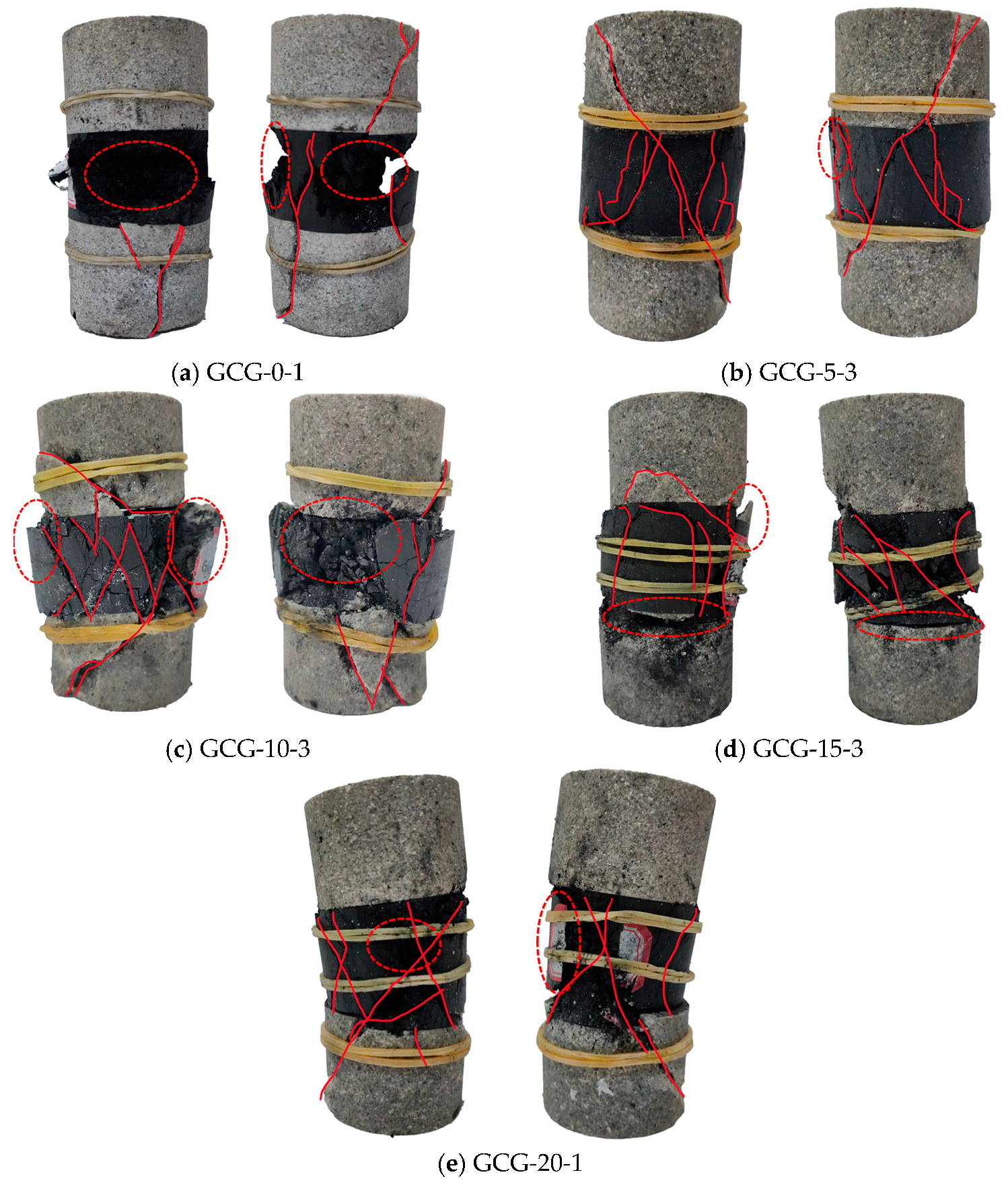

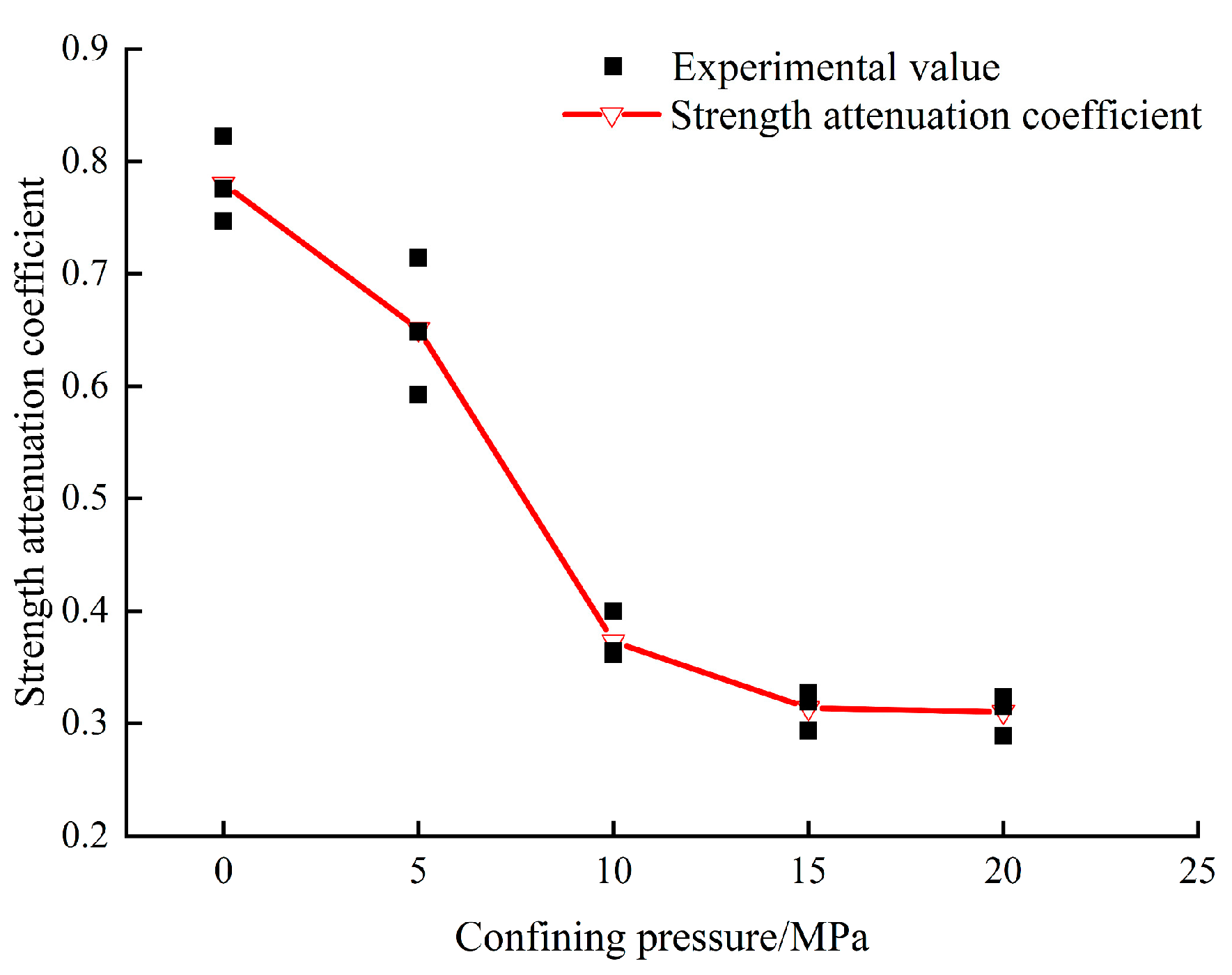

| Rock Formation | Diameter/mm | Height/mm | Compressive Strength/MPa | Elastic Modulus/GPa | Modulus of Deformation/GPa |
|---|---|---|---|---|---|
| Gritstone | 50 | 100 | 37.71 | 6.97 | 3.67 |
| Coal Samples | 50 | 100 | 21.17 | 2.17 | 2.05 |
| Specimen Number | Range Finding/mm | Voice Time/μs | Average Velocity/(km · s) | Sound Velocity Correction Value/(km · s) |
|---|---|---|---|---|
| GCG-0-1 | 100 | 37.5 | 2.67 | 2.76 |
| GCG-0-2 | 100 | 38.5 | 2.59 | 2.69 |
| GCG-0-3 | 100 | 38.5 | 2.59 | 2.69 |
| GCG-5-1 | 100 | 39.5 | 2.53 | 2.62 |
| GCG-5-2 | 100 | 38.5 | 2.6 | 2.69 |
| GCG-5-3 | 100 | 40.5 | 2.47 | 2.55 |
| GCG-10-1 | 100 | 39.5 | 2.53 | 2.62 |
| GCG-10-2 | 100 | 37.5 | 2.67 | 2.76 |
| GCG-10-3 | 100 | 41.5 | 2.41 | 2.49 |
| GCG-15-1 | 100 | 40 | 2.5 | 2.58 |
| GCG-15-2 | 100 | 41 | 2.44 | 2.52 |
| GCG-15-3 | 100 | 38 | 2.63 | 2.72 |
| GCG-20-1 | 100 | 39.5 | 2.53 | 2.62 |
| GCG-20-2 | 100 | 39.5 | 2.53 | 2.62 |
| GCG-20-3 | 100 | 37 | 2.7 | 2.79 |
| Specimen Number | E/GPa | σ1/MPa | σ3/MPa | σr/MPa | ε/10−3 |
|---|---|---|---|---|---|
| GCG-0-1 | 4.12 | 41.41 | 0 | 10.5 | 3.91 |
| GCG-0-2 | 5.15 | 38.96 | 0 | 6.93 | 4.2 |
| GCG-0-3 | 6.43 | 51.38 | 0 | 11.54 | 3.59 |
| GCG-5-1 | 5.94 | 65.13 | 5 | 42.7 | 5.96 |
| GCG-5-2 | 5.76 | 57.95 | 5 | 32.31 | 4.2 |
| GCG-5-3 | 5.81 | 79.48 | 5 | 27.97 | 5.01 |
| GCG-10-1 | 9.18 | 80.62 | 10 | 47.22 | 7.15 |
| GCG-10-2 | 12.69 | 94.39 | 10 | 66.76 | 8.14 |
| GCG-10-3 | 11.02 | 90.93 | 10 | 57.83 | 6.51 |
| GCG-15-1 | 16.51 | 98.91 | 15 | 60.69 | 7.86 |
| GCG-15-2 | 14.55 | 105.39 | 15 | 68.93 | 9.75 |
| GCG-15-3 | 12.23 | 109.79 | 15 | 73.98 | 9.04 |
| GCG-20-1 | 12.52 | 114.7 | 20 | 78.59 | 8.68 |
| GCG-20-2 | 15.83 | 119.22 | 20 | 69.89 | 7.74 |
| GCG-20-3 | 13.65 | 123.54 | 20 | 85.66 | 9.46 |
| Confining pressure/MPa | 0 | 5 | 10 | 15 | 20 |
| Strength attenuation coefficient of rock | 0.780 | 0.590 | 0.354 | 0.352 | 0.345 |
| Strength Criterion | m | s | R2 |
|---|---|---|---|
| H–B | 9.923 | 0.786 | 0.9433 |
| GH–B | 4.234 | 0.867 | 0.9209 |
| Based on H–B iteration | 9.596 | 0.898 | 0.9500 |
Disclaimer/Publisher’s Note: The statements, opinions and data contained in all publications are solely those of the individual author(s) and contributor(s) and not of MDPI and/or the editor(s). MDPI and/or the editor(s) disclaim responsibility for any injury to people or property resulting from any ideas, methods, instructions or products referred to in the content. |
© 2023 by the authors. Licensee MDPI, Basel, Switzerland. This article is an open access article distributed under the terms and conditions of the Creative Commons Attribution (CC BY) license (https://creativecommons.org/licenses/by/4.0/).
Share and Cite
Wang, H.; Chang, J.; Wang, T.; Zhang, H.; Guo, Y. Mechanical Properties and Strength Characteristics of Rock–Coal–Rock Assemblages under Different Peripheral Pressures. Sustainability 2023, 15, 12463. https://doi.org/10.3390/su151612463
Wang H, Chang J, Wang T, Zhang H, Guo Y. Mechanical Properties and Strength Characteristics of Rock–Coal–Rock Assemblages under Different Peripheral Pressures. Sustainability. 2023; 15(16):12463. https://doi.org/10.3390/su151612463
Chicago/Turabian StyleWang, Hongda, Jucai Chang, Tuo Wang, Hualei Zhang, and Yijun Guo. 2023. "Mechanical Properties and Strength Characteristics of Rock–Coal–Rock Assemblages under Different Peripheral Pressures" Sustainability 15, no. 16: 12463. https://doi.org/10.3390/su151612463
APA StyleWang, H., Chang, J., Wang, T., Zhang, H., & Guo, Y. (2023). Mechanical Properties and Strength Characteristics of Rock–Coal–Rock Assemblages under Different Peripheral Pressures. Sustainability, 15(16), 12463. https://doi.org/10.3390/su151612463






